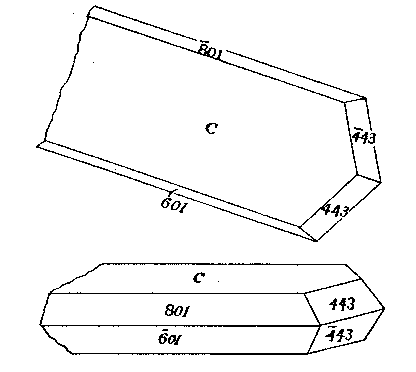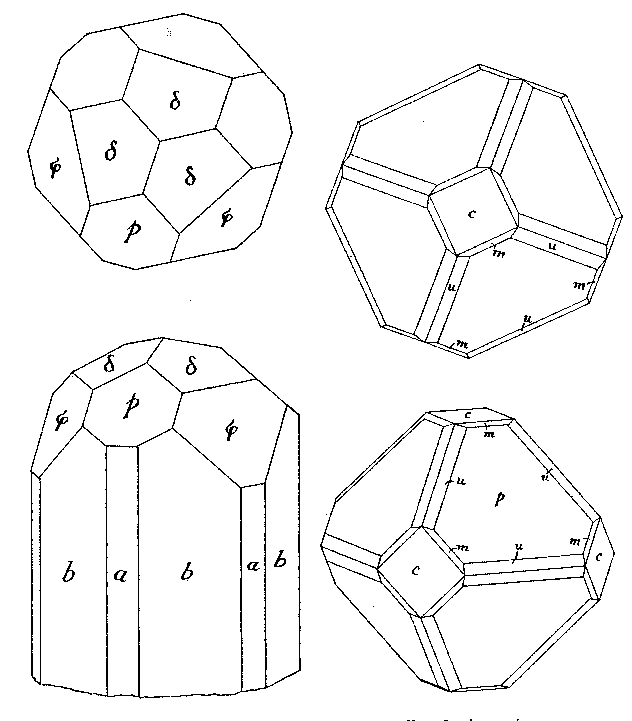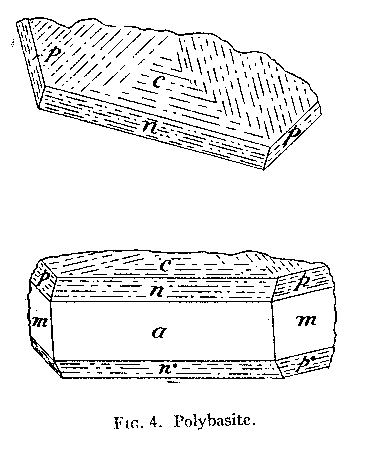| Home | AmMin | GMR | RiMG | Collectors Corner | Directory | Short Courses | |
|
|
|||||||

|
|
Volume 13, pages 469-475, 1928 XANTHOCONITE AND ASSOCIATED MINERALS FROM THE GENERAL PETITE MINE, ATLANTA DISTRICT, IDAHO EARL V. SHANNON,1 U. S. National Museum. The exceedingly rare mineral xanthoconite has the formula 3Ag2S·As2S3 and is, therefore, a dimorphous form of the same compound as proustite. An antimonial analogue of xanthoconite is known in the mineral pyrostilpnite or fireblende, corresponding in composition with pyrargyrite. Dana gives the crystal form of xanthoconite as rhombohedral and mentions the Himmelsfürst mine, near Freiberg, as the only locality. This symmetry was given by Breithaupt and was determined on fragments of a single crystal which had been broken into several pieces before measurement. The material occurred associated with proustite, the xanthoconite making up reniform masses with a surface consisting of microscopic crystals, and with a crystalline-granular interior. The specimen was mined in 1797 and described from the Berg-Akademie collection in 1840. In 1893 Miers2 published an exhaustive examination of this mineral which proved the identity of xanthoconite and rittingerite. The occurrence of the mineral at several European localities - Freiberg, Johanngeorgenstadt, Rudelstadt and Markirch, Elsass, as well as Chañarcillo, Chile, is established. The crystallography is discussed at length and it is shown that the mineral is monoclinic, usually thin tabular parallel to c(001), and that the crystals are most frequently composed of overlapping plates, which are also twinned, united by the face c. The identity in geometrical form with pyrostilpnite is demonstrated. The first mention of the occurence of xanthoconite in North America is by Browne3 who in 1868 stated that "xanthocone" was one of the silver minerals present in rich ores of the Flint district in Owyhee county, Idaho. In the work on the minerals of that State4 no trace of this mineral was found nor any further reference to it. The only reason for seriously crediting Browne's report was that he was well acquainted with silver minerals and, having been educated at Freiberg, was doubtless familiar with the type specimens of xanthoconite in the Berg-Akademie's collection. The second North American locality for this mineral, mentioned in the literature, is the La Rose mine at Cobalt, Ontario. This was described by Parsons5 in 1924. The single specimen from this locality is described as having the xanthoconite in the form of buffy-brown, approximately hemispherical radiated aggregates, and a few isolated crystals associated with proustite. In view of the rarity of the mineral the writer was much interested to find in the Roebling collection a specimen of xanthoconite from a second locality in Idaho. The label accompanying this specimen states that it was purchased from Lazard Cahn and was found in 1908 at the General Petite mine in the Atlanta district in Elmore county. This district is almost exactly 100 miles in an air line from the district in which the mineral was reported by Browne. The small specimen consists chiefly of a mass of lustrous argentite, without crystalline boundaries, containing small and perfect embedded prismatic crystals of colorless quartz. Even where their bases are embedded in solid argentite, the quartz crystals are broken across at one end showing that they were formed and broken loose from their point of attachment before deposition of the silver sulphide. The argentite thus forms an abundant matrix for a breccia of euhedral quartz crystals. Molds left by removal of the quartz crystals show thin yellow smears which are apparently native gold. Proustite, argentite, arsenopyrite and polybasite, in small perfect crystals rest upon the massive argentite, and the xanthoconite forms hemispherical masses up to 2 millimeters in diameter deposited around, and apparently later than, the proustite. The order of genesis of the minerals of the specimen is then: 1. Quartz 2. Gold 3. Argentite 4. Proustite Arsenopyrite Polybasite Argentite 5. Xanthoconite The hemispherical masses of xanthoconite are golden yellow to brownish-yellow in color, and are crystalline-granular within and covered on the outside with very thin tabular crystals not exceeding 0.1 millimeter in greatest diameter. In general they have a thickness of 0.01 millimeter or less. It will be noted that in color, in the tendency to aggregation into crystalline-granular drusy hemispherical or mammillary forms, and in its association with proustite, the Idaho xanthoconite of this occurrence is almost identical with the original specimen from the Himmelsfürst mine, Saxony, and with the material from Cobalt, Ontario. FIG. 1. Xanthoconite.
The Idaho xanthoconite crystals are almost entirely unsuited for goniometric study. They are very minute and exceedingly
thin and the faces are imperfect. Further, the larger crystals are compound, being made up of several individuals which
are not quite in parallel position. In addition to being almost too small to handle they are so flexible and fragile
that they are invariably either bent or shattered in detaching them from their matrix. One which was set up with the
broad face c(001) in the polar position gave no reflections from other faces. Another which was set up with the b axis
vertical had the form and appearance of figure 1. This gave confused groups of signals from the two faces of c(001).
Reflections but no signals were obtained from four orthodome faces. One of these, taken as positive, gave an angle from the base of
72½ °, which is near (601), the rho
(ρ) angle for which is 72°38' (001^601=71°25"). The negative dome gave an interfacial angle of 77° which roughly
corresponds to -80 (801), the rho (ρ) angle for which is 76°46"(001^801= 77°59'). The positive pyramid
reflecting corresponded very roughly with (443) Goldschmidt and, from its relative position, the other was assumed to be
( Optically examined under the polarizing microscope the euhedral crystals are yellow in color and not noticeably pleochroic. They show very high refractive indices and moderately high birefringence. Euhedral crystals lying on the flat side show a bisectrix perpendicular to c(001), with large axial angle and the optic plane parallel to the elongation which is positive. Assuming that this is the acute bisectrix, 2E is very large and the mineral is optically negative, the orientation being X near c, Y=near a, Z=b. The proustite forms very brilliant, transparent, red crystals not exceeding 1.5 millimeters in length resting upon the argentite, either singly or in small divergent groups. In one case a cruciform penetration twin was seen but was not measured. Despite the excellent appearance of the crystals, they were not well suited for crystallographic measurement as the signals are blurred and multiplied by striations. The faces also were rounded. The crystals are short, prismatic and terminated by faces of three rhombohedrons, the form and habit being as shown in figure 2. The angles measured are as follows: FIG. 2. Proustite FIG. 3. Argentite.
Although the main mass of the argentite forming the core of the specimen is without crystal form, there occur rarely on this, or attached to a quartz crystal, some scattered very minute. but highly perfect and lustrous black argentite crystals. One of these which was measured showed the forms and angles of figure 3. The average diameter of these argentite crystals is only about 0.2 millimeter. Attached to the argentite crystal that was measured were some very minute, long prismatic crystals of arsenopyrite. The argentite crystal, which is figured, gave the following angular measurements: In addition to the rare argentite crystals there also occur, resting upon the massive argentite, very minute lustrous black, hexagonal, tabular crystals of polybasite. These give reactions for sulphur, antimony and silver and negative reactions when tested for arsenic. They are very minute. One which was measured had the form shown in figure 4. This was 0.6 mm. broad with a thickness of 0.2 mm. The basal pinacoid was striated in three directions as shown in the drawing. The angles measured are compared with the angles for this mineral given in Goldschmidt's Winkeltabellen. Fie.. 4. Polybasite.
The occurrence of so large a number of minerals in one small specimen is very unusual. Of these the age relationship between quartz, massive argentite, proustite and xanthoconite, as stated above, is clear. The proustite, crystallized argentite, polybasite, and arsenopyrite are not in such a position with reference to each other that their paragenesis can be determined. They may be more or less contemporaneous. The whole assemblage is doubtless epigene, and not in any sense due to secondary downward enrichment. NOTES 1 Published by permission of the Acting Secretary of the Smithsonian Institution. 2 H. A. Miers. Xanthoconite and rittingerite, with remarks on the red silvers. Mineralog. Mag., 10, pp. 185-216, 1893. 3 J. Ross Browne. Mineral Resources U. S. for 1868, p. 528. 4 Earl V. Shannon. The minerals of Idaho. U. S. National Museum Bulletin 131, 1926. 5 A. L. Parsons. Xanthoconite from Cobalt, Ontario. Contributions to Canadian mineralogy, 1924. Univ. Toronto Geological Series, No. 17, pp. 11-12, 1924. {DVB for tables with angles between faces see original article}
|


